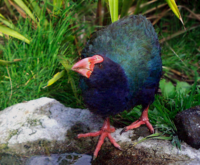- Takahe
-
Als Takahe (Takahē) bezeichnet man zwei einander sehr ähnliche flugunfähige Vogelarten Neuseelands: die Südinseltakahe (Porphyrio hochstetteri) und die ausgestorbene Nordinseltakahe (Porphyrio mantelli), die zu den Purpurhühnern zählen.[1]
1848 beschrieb Richard Owen anhand von Knochenfunden von W. B. Mantell die Nordinseltakahe unter dem Namen Notornis mantelli. Ein Jahr später fing Mantell eine Südinseltakahe, die von Adolf Bernhard Meyer 1883 als Notornis hochstetteri benannt wurde. Die Gattung Notornis umfasste damit zwei Arten flugunfähiger Rallen. 1923 wurde erstmals vorgeschlagen, die Nordinsel- und die Südinseltakahe als Unterarten einer einzigen Art zu führen, die dann N. mantelli subsp. mantelli und N. mantelli subsp. hochstetteri hießen. Das wurde in den folgenden Jahren allgemein akzeptiert. [2][3][4]
1988 setzte sich die Auffassung durch, dass Takahes sehr nahe mit dem Purpurhuhn (Porphyrio porphyrio) verwandt sind und sich erst vor etwa 2 Millionen Jahren von diesem abgetrennt haben. Deshalb werden sie heute trotz der durch die Flugunfähigkeit bedingten Änderungen des Skeletts der Gattung Porphyrio zugeordnet.[5]
1996 wurde durch eine morphometrische Untersuchung bestätigt, dass es sich bei den beiden Takahes um getrennte Arten handelt. Durch Trewick wurde 1997 bewiesen, dass sich die beiden Arten genetisch so sehr unterscheiden, dass sie nicht nur unterschiedliche Arten sind, sondern sich auch noch unabhängig voneinander aus derselben Art oder zwei nahe verwandten ähnlichen flugfähigen Arten entwickelt haben.[1][6][7][8]
Die Takahē ernähren sich vorwiegend von Tussock-Grass, deshalb sind die von den europäischen Einwanderern eingeführten Hirscharten ihre größten Fressfeinde. Da sie flugunfähig sind, werden ihr Eier von verschiedenen Säugetieren, die die Menschen eingeführt haben, gerne verzehrt und ihre Jungen gejagt und gefressen.
Einzelnachweise
- ↑ a b Steven A. Trewick: Sympatric flightless rails Gallirallus dieffenbachii and G. modestus on the Chatham Islands, New Zealand; morphometrics and alternative evolutionary scenarios. In: Journal of the Royal Society of New Zealand. Volume 27, Number 4, Dezember 1997, Seiten 451–464. doi:10.1080/03014223.1997.9517548
- ↑ G. R. Williams: The Takahe (Notornis mantelli Owen, 1848): A General Survey. In: Transactions and Proceedings of the Royal Society of New Zealand 1868-1961. Volume 88, 1960-61, Seiten 235–258. (online)
- ↑ Brian Reid: Sightings and records of the takahae “Notornis mantelli” prior to its “official rediscovery” by Dr. G. B. Orbell in 1948. In: Notornis. Volume 21, Part 4, Dezember 1974, Seiten 277–295.
- ↑ T. Jeffery Parker: On the Skeleton of Notornis mantelli. In: Transactions and Proceedings of the Royal Society of New Zealand 1868-1961. Volume 14, 1881, Art. XXXII., Seiten 245–258. (online)
- ↑ Judah S. Bunin, Ian G. Jamieson: A cross-fostering experiment between the endangered takahe (Porphyrio mantelli) and its closest relative, the pukeko (P. porphyrio). In: New Zealand Journal of Ecology [N. Z. J. ECOL.]. Volume 20, Number 2, 1996, Seiten 207–213. (online)
- ↑ Steven A. Trewick: Flightlessness and phylogeny amongst endemic rails (Aves: Rallidae) of the New Zealand region. In: Philosophical Transactions of the Royal Society of London. Series B, Volume 352,Nummer 1352, April 1997, Seiten 429-446 doi:10.1098/rstb.1997.0031
- ↑ Bradley C. Livecey: A phylogenetic analysis of the Gruiformes (Aves) based on morphological characters, with an emphasis on the rails (Rallidae). In: Philosophical Transactions of the Royal Society of London. Series B, Volume 353, Nummer 1378, Dezember 1998, Seiten 2077-2151 doi:10.1098/rstb.1998.0353
- ↑ Ian G. Jamieson, Christine J. Ryan: Increased egg infertility associated with translocating inbred takahe (Porphyrio hochstetteri) to island refuges in New Zealand. In: Biological Conservation. Volume 94, Issue 1, Juni 2000, Seiten 107-114. doi:10.1016/S0006-3207(99)00158-5
Wikimedia Foundation.

